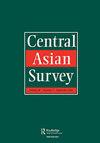Soviet policy in Xinjiang: Stalin and the national movement in Eastern Turkistan
IF 1.1
3区 社会学
Q2 AREA STUDIES
引用次数: 0
Abstract
view. The Soviet system worked on dual tracks, celebrating diversity while embedding Russian superiority. The structural embedding was the stronger force. Edgar is more concerned with the messiness of lives lived than with theory, which is a great strength of the book. Her informants span generations, from those whomet in the chaos of the Second World War to the children of perestroika. Marriages between Muslims and non-Muslims were rare, and when they occurred they were almost always between Muslim men and Slavic women. Edgar considers the minefields of relations with the in-laws, cultural identity and language as well as marriages that were happy or unhappy in general. While Edgar stresses that the data are not systematic enough to support rigorous analysis, broad patterns do emerge. Families tended to be hostile to the idea of mixed marriage, except for the most dedicated communists. The appearance of grandchildren usually fixed that problem, but not always. A major concern for Kazakh and especially Tajik families was that the Slavic bride would not fulfil expected duties to her in-laws with the appropriate deference. While some brides did indeed chafe at the model of the selfless ‘Eastern woman’, others embraced it as providing a more supportive network than Soviet Russian family dysfunction. Meanwhile the few Central Asian women who married Slavs were attracted to their husbands’ less patriarchal demeanour. Raising children posed many dilemmas: What to name them? Whose language should they speak? Whose nationality should they claim on their passports when they turned 16? Like mixed couples everywhere, parents made choices depending on practical considerations and family and personal opinions. However, the Soviet insistence on distinct, stable national categories forced particular choices. While few multi-ethnic children reported being harassed by their peers, a child with an Islamic name and a Slavic appearance, or vice versa, caused consternation. Parents tried to match names with physiognomy. Many of these children were raised with Russian as their first language, but if neither of their parents were Russian they could not claim ‘Russian’ on their passports, no matter how much Pushkin they had imbibed. If they did not identify with the nationality of either parent, or if they believed they were Soviet citizens first and foremost, the state did not allow them to choose ‘both’ or ‘none’. The Communist Party said it was working toward a world without nations, but underneath its actions were driven by older ideas of fixed racial and gender hierarchies that permeated Soviet society. Edgar’s study provides a fascinating window into these contradictions.苏联新疆政策:斯大林与东突民族运动
看法苏联的体制走上了双轨制,既庆祝多样性,又嵌入了俄罗斯的优势。结构嵌入是更强的力量。埃德加更关心生活的混乱,而不是理论,这是本书的一大优势。她的线人跨越了几代人,从第二次世界大战混乱中的人到改革的孩子。穆斯林和非穆斯林之间的婚姻很少见,当发生时,几乎总是穆斯林男性和斯拉夫女性之间的婚姻。埃德加考虑了与姻亲、文化身份和语言的关系雷区,以及总体上幸福或不幸福的婚姻。Edgar强调,这些数据不够系统,无法支持严格的分析,但确实出现了广泛的模式。除了最忠诚的共产主义者外,家庭往往对混合婚姻持敌对态度。孙辈的出现通常解决了这个问题,但并不总是如此。哈萨克家庭,尤其是塔吉克家庭的一个主要担忧是,斯拉夫新娘不会在适当尊重的情况下履行对姻亲的期望义务。虽然一些新娘确实对无私的“东方女性”模式感到恼火,但其他新娘则认为这是一个比苏俄家庭功能障碍更具支持性的网络。与此同时,少数嫁给斯拉夫人的中亚妇女被丈夫不那么重男轻女的举止所吸引。养育孩子带来了许多难题:给他们起什么名字?他们应该说谁的语言?当他们年满16岁时,他们应该在护照上申请谁的国籍?就像世界各地的混血夫妇一样,父母根据实际考虑、家庭和个人意见做出选择。然而,苏联坚持不同的、稳定的国家类别,迫使他们做出特殊的选择。虽然很少有多民族儿童报告称受到同龄人的骚扰,但一个有伊斯兰名字和斯拉夫血统的儿童,或反之亦然,引起了恐慌。家长们试着把名字和面相搭配起来。这些孩子中的许多人是以俄语为第一语言长大的,但如果他们的父母都不是俄罗斯人,他们就不能在护照上声称自己是“俄罗斯人”,无论他们喝了多少普希金酒。如果他们不认同父母中任何一方的国籍,或者他们认为自己首先是苏联公民,国家不允许他们选择“两者都有”或“没有”。共产党表示,它正在努力建设一个没有国家的世界,但其行动的背后是苏联社会中根深蒂固的种族和性别等级观念。埃德加的研究为了解这些矛盾提供了一扇迷人的窗口。
本文章由计算机程序翻译,如有差异,请以英文原文为准。
求助全文
约1分钟内获得全文
求助全文

 求助内容:
求助内容: 应助结果提醒方式:
应助结果提醒方式:


